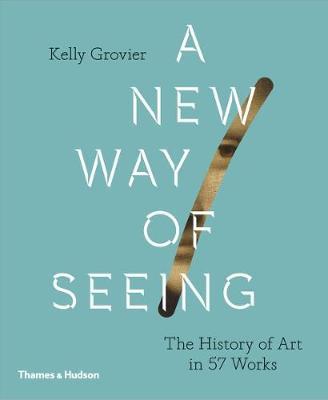New Way of Seeing

New Way of Seeing
Unsatisfied with traditional, hand-me-down interpretations of these masterpieces interested only in learning about art, and not from it, Kelly Grovier combed the surface of revered works from the Terracotta Army of the First Qin Emperor to Frida Kahlo's self-portraits. What did he find? The key to their enduring power to move and delight us. He discovered that every truly great work is hardwired with an underappreciated detail, a flourish of strangeness, that ignites it from deep inside.
From a carved mammoth tusk (c. 40,000 bce) to Duchamp's Fountain (1917), and Bosch's Garden of Earthly Delights (1505-10) to Louise Bourgeois's Maman (1999), a remarkable lexicon of astonishing imagery has imprinted itself onto cultural consciousness over the past 40,000 years - a resilient visual vocabulary whose meaning has proved elastic and endlessly renewable from era to era.
It is to these works that Kelly Grovier devotes himself in this radical new art history. Stepping away from biography, style and the chronology of `isms' that preoccupies most art history to focus on the artworks themselves, Grovier tells a new story in which we learn from the artworks, not just about them. Looking closely at each work, he identifies an `eye-hook' - the part of the artwork that `bridges the divide between art and life, giving it palpable purpose and elevating its value beyond the visual to the vital' - and encourages us to squint through this narrow aperture to perceive the work's truest meanings. This book is unique in emphasizing the durability of what is made over the ephemerality of its making and serves as a rejoinder to a growing sensibility that conceives of artists as brands and the works they create as nothing more than material commodities to hoard, hide, and flip for profit.
Lavishly illustrated with many of the most breathtaking
PRP: 250.00 Lei
Acesta este Prețul Recomandat de Producător. Prețul de vânzare al produsului este afișat mai jos.
200.00Lei
200.00Lei
250.00 LeiIndisponibil
Descrierea produsului
Unsatisfied with traditional, hand-me-down interpretations of these masterpieces interested only in learning about art, and not from it, Kelly Grovier combed the surface of revered works from the Terracotta Army of the First Qin Emperor to Frida Kahlo's self-portraits. What did he find? The key to their enduring power to move and delight us. He discovered that every truly great work is hardwired with an underappreciated detail, a flourish of strangeness, that ignites it from deep inside.
From a carved mammoth tusk (c. 40,000 bce) to Duchamp's Fountain (1917), and Bosch's Garden of Earthly Delights (1505-10) to Louise Bourgeois's Maman (1999), a remarkable lexicon of astonishing imagery has imprinted itself onto cultural consciousness over the past 40,000 years - a resilient visual vocabulary whose meaning has proved elastic and endlessly renewable from era to era.
It is to these works that Kelly Grovier devotes himself in this radical new art history. Stepping away from biography, style and the chronology of `isms' that preoccupies most art history to focus on the artworks themselves, Grovier tells a new story in which we learn from the artworks, not just about them. Looking closely at each work, he identifies an `eye-hook' - the part of the artwork that `bridges the divide between art and life, giving it palpable purpose and elevating its value beyond the visual to the vital' - and encourages us to squint through this narrow aperture to perceive the work's truest meanings. This book is unique in emphasizing the durability of what is made over the ephemerality of its making and serves as a rejoinder to a growing sensibility that conceives of artists as brands and the works they create as nothing more than material commodities to hoard, hide, and flip for profit.
Lavishly illustrated with many of the most breathtaking
Detaliile produsului









